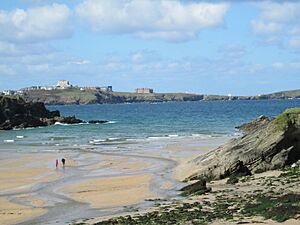Porth, Cornwall facts for kids
Quick facts for kids Porth
|
|
|---|---|
| Hamlet | |
| Civil parish | |
| Unitary authority | |
| Ceremonial county | |
| Region | |
| Country | England |
| Sovereign state | United Kingdom |
| Post town | Newquay |
| Postcode district | TR7 |
| Dialling code | 01637 |
| Police | Devon and Cornwall |
| Fire | Cornwall |
| Ambulance | South Western |
| EU Parliament | South West England |
| Website | https://www.newquay.gov.uk/ |
Porth is a small seaside village, also called a hamlet. It is located in Cornwall, England, near the town of Newquay. Porth sits next to a beautiful sandy bay, which is about 1 kilometer (0.6 miles) long. On the northern side of the bay, you can see Trevelgue Head. This is an ancient hill fort from the Iron Age, a very long time ago!
Porth was once known as St. Columb Porth. It used to be a small port for the nearby village of St Columb Minor. Ships would bring in important goods like coal, salt, and lime. They also carried many other general items needed by the people living there.
Contents
Porth's Past: A Busy Port
Porth's full name, St Columb Porth, means 'the port of St Columb'. It was part of the St Columb Minor area for a long time. Now, it is officially part of the Newquay local government area. However, the church area of St Columb Minor still exists.
Before Newquay became a big town, St. Columb Porth was a small port and a farming settlement. The long, sheltered bay is actually an old river mouth that got filled by the sea. In the 1800s, the tide reached far inland, almost 3 kilometers (2 miles) to a place called Rialton. This made it a perfect spot for ships to unload goods for St. Columb Minor village.
Ships brought in coal, salt, and lime. They also carried many other general supplies. From Porth, they would take away grain, and later, china clay and stone. When Newquay became a major china clay port, ships would first drop off coal at Porth beach. Then, they would continue to Newquay to load up china clay.
Some old buildings still stand in Porth. Cavern Cottage on Alexandra Road was built in the mid-1800s using stone. It is now a protected building. The oldest cottage still standing is Gwenna. It was built in the early 1600s! Its lower walls are made of "cob," a mix of clay, stones, and straw. The main farm building was Morvah, built around 1660. Behind Morvah are old stables, now used as cottages. Beyond them is Concord Cottage. This building once stored salt and fishing nets for the Concord Pilchard Sein Fishing Company. A fish cellar was built in 1804 but closed in 1846. Its ruins are still behind the cottage. Fishing boats were built along the sea wall behind this cellar.
Before 1902, there was no bridge to cross the river at Porth. People and carts had to drive across the beach and through the river to get to Watergate Road.
The Porth Valley has been used for many things. People dug for slate from the valley sides. Tin was also mined from the valley gravels in the 1830s. The Morganna Mine operated here in the mid-1800s. You can still see the mine tunnels, called adits, near the steps to Whipsiderry Beach. Clay from the valley was used to make bricks. Many of these bricks helped build the Atlantic Hotel in 1892. A shipyard once stood at the first inlet on the Headland, near Watergate Road. Two large sailing ships called schooners were built there in 1857-1858. More ships were built between 1875 and 1880.
Glendorgal: A Historic Home
On the southern side of Porth is the Glendorgal Hotel. It was first built in 1850 as a large house for a wealthy person. In 1878, it became the home of Arthur Pendarves Vivian. He was a member of parliament for West Cornwall. He made many changes to the house that year.
In 1882, Sir Richard Trevithick Tangye bought Glendorgal. Sir Richard was a Cornishman born in Illogan. He became a successful mechanical engineer. With his brothers, he started an engineering company in Birmingham. Glendorgal then became the home of the Tangye Baronetcy. This special title was given to Harold Tangye, Sir Richard's son, in 1912.
Three generations of the Tangye family lived at Glendorgal. This included Sir Richard's grandson, Derek Tangye. Derek was a famous author. He wrote the "Minack Chronicles," a series of nineteen books. These books were based on his life on a small farm near Lamorna Cove in West Cornwall. In 1950, Derek's brother, Nigel Tangye, opened the house as a hotel.
Porth Veor Manor: A Hotel with a Story
The Porth Veor Manor Hotel was designed by a Cornish architect named Silvanus Trevail. It was built in 1879. Mr. William Stephens was the first owner of Porth Veor.
This hotel is located high up, looking over Porth beach. In the 1920s, the Porth Veor Manor hotel was owned and run by the author Charlotte Mary Matheson and her husband, Stanley Threlkeld. Charlotte was a well-known woman farmer. She wrote several novels, including The Generation Between, which you can still find today.
Famous People Connected to Porth
Some notable people have lived in or been connected to Porth:
- Charlotte Mary Matheson: An English novelist who lived from 1892 to 1937.
- James Morrison (singer): A popular singer.
- Sir Basil Richard Gilzean Tangye: The 2nd Baronet, who lived from 1912 to 1969.
- Derek Tangye: An author and the grandson of Sir Richard Tangye.
- Nigel Tangye: Derek Tangye's brother and the husband of actress Ann Todd.
- Sir Richard Tangye: A famous engineer.


